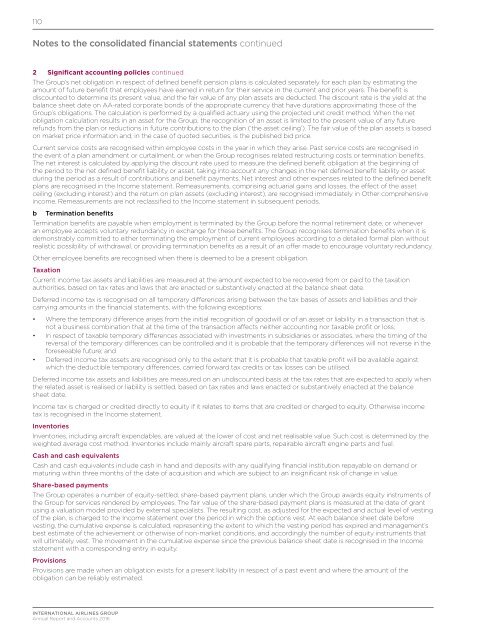Annual report and accounts 2016
Create successful ePaper yourself
Turn your PDF publications into a flip-book with our unique Google optimized e-Paper software.
110<br />
Notes to the consolidated financial statements continued<br />
2 Significant accounting policies continued<br />
The Group’s net obligation in respect of defined benefit pension plans is calculated separately for each plan by estimating the<br />
amount of future benefit that employees have earned in return for their service in the current <strong>and</strong> prior years. The benefit is<br />
discounted to determine its present value, <strong>and</strong> the fair value of any plan assets are deducted. The discount rate is the yield at the<br />
balance sheet date on AA-rated corporate bonds of the appropriate currency that have durations approximating those of the<br />
Group’s obligations. The calculation is performed by a qualified actuary using the projected unit credit method. When the net<br />
obligation calculation results in an asset for the Group, the recognition of an asset is limited to the present value of any future<br />
refunds from the plan or reductions in future contributions to the plan (‘the asset ceiling’). The fair value of the plan assets is based<br />
on market price information <strong>and</strong>, in the case of quoted securities, is the published bid price.<br />
Current service costs are recognised within employee costs in the year in which they arise. Past service costs are recognised in<br />
the event of a plan amendment or curtailment, or when the Group recognises related restructuring costs or termination benefits.<br />
The net interest is calculated by applying the discount rate used to measure the defined benefit obligation at the beginning of<br />
the period to the net defined benefit liability or asset, taking into account any changes in the net defined benefit liability or asset<br />
during the period as a result of contributions <strong>and</strong> benefit payments. Net interest <strong>and</strong> other expenses related to the defined benefit<br />
plans are recognised in the Income statement. Remeasurements, comprising actuarial gains <strong>and</strong> losses, the effect of the asset<br />
ceiling (excluding interest) <strong>and</strong> the return on plan assets (excluding interest), are recognised immediately in Other comprehensive<br />
income. Remeasurements are not reclassified to the Income statement in subsequent periods.<br />
b Termination benefits<br />
Termination benefits are payable when employment is terminated by the Group before the normal retirement date, or whenever<br />
an employee accepts voluntary redundancy in exchange for these benefits. The Group recognises termination benefits when it is<br />
demonstrably committed to either terminating the employment of current employees according to a detailed formal plan without<br />
realistic possibility of withdrawal, or providing termination benefits as a result of an offer made to encourage voluntary redundancy.<br />
Other employee benefits are recognised when there is deemed to be a present obligation.<br />
Taxation<br />
Current income tax assets <strong>and</strong> liabilities are measured at the amount expected to be recovered from or paid to the taxation<br />
authorities, based on tax rates <strong>and</strong> laws that are enacted or substantively enacted at the balance sheet date.<br />
Deferred income tax is recognised on all temporary differences arising between the tax bases of assets <strong>and</strong> liabilities <strong>and</strong> their<br />
carrying amounts in the financial statements, with the following exceptions:<br />
• Where the temporary difference arises from the initial recognition of goodwill or of an asset or liability in a transaction that is<br />
not a business combination that at the time of the transaction affects neither accounting nor taxable profit or loss;<br />
• In respect of taxable temporary differences associated with investments in subsidiaries or associates, where the timing of the<br />
reversal of the temporary differences can be controlled <strong>and</strong> it is probable that the temporary differences will not reverse in the<br />
foreseeable future; <strong>and</strong><br />
• Deferred income tax assets are recognised only to the extent that it is probable that taxable profit will be available against<br />
which the deductible temporary differences, carried forward tax credits or tax losses can be utilised.<br />
Deferred income tax assets <strong>and</strong> liabilities are measured on an undiscounted basis at the tax rates that are expected to apply when<br />
the related asset is realised or liability is settled, based on tax rates <strong>and</strong> laws enacted or substantively enacted at the balance<br />
sheet date.<br />
Income tax is charged or credited directly to equity if it relates to items that are credited or charged to equity. Otherwise income<br />
tax is recognised in the Income statement.<br />
Inventories<br />
Inventories, including aircraft expendables, are valued at the lower of cost <strong>and</strong> net realisable value. Such cost is determined by the<br />
weighted average cost method. Inventories include mainly aircraft spare parts, repairable aircraft engine parts <strong>and</strong> fuel.<br />
Cash <strong>and</strong> cash equivalents<br />
Cash <strong>and</strong> cash equivalents include cash in h<strong>and</strong> <strong>and</strong> deposits with any qualifying financial institution repayable on dem<strong>and</strong> or<br />
maturing within three months of the date of acquisition <strong>and</strong> which are subject to an insignificant risk of change in value.<br />
Share-based payments<br />
The Group operates a number of equity-settled, share-based payment plans, under which the Group awards equity instruments of<br />
the Group for services rendered by employees. The fair value of the share-based payment plans is measured at the date of grant<br />
using a valuation model provided by external specialists. The resulting cost, as adjusted for the expected <strong>and</strong> actual level of vesting<br />
of the plan, is charged to the Income statement over the period in which the options vest. At each balance sheet date before<br />
vesting, the cumulative expense is calculated, representing the extent to which the vesting period has expired <strong>and</strong> management’s<br />
best estimate of the achievement or otherwise of non-market conditions, <strong>and</strong> accordingly the number of equity instruments that<br />
will ultimately vest. The movement in the cumulative expense since the previous balance sheet date is recognised in the Income<br />
statement with a corresponding entry in equity.<br />
Provisions<br />
Provisions are made when an obligation exists for a present liability in respect of a past event <strong>and</strong> where the amount of the<br />
obligation can be reliably estimated.<br />
INTERNATIONAL AIRLINES GROUP<br />
<strong>Annual</strong> Report <strong>and</strong> Accounts <strong>2016</strong>



